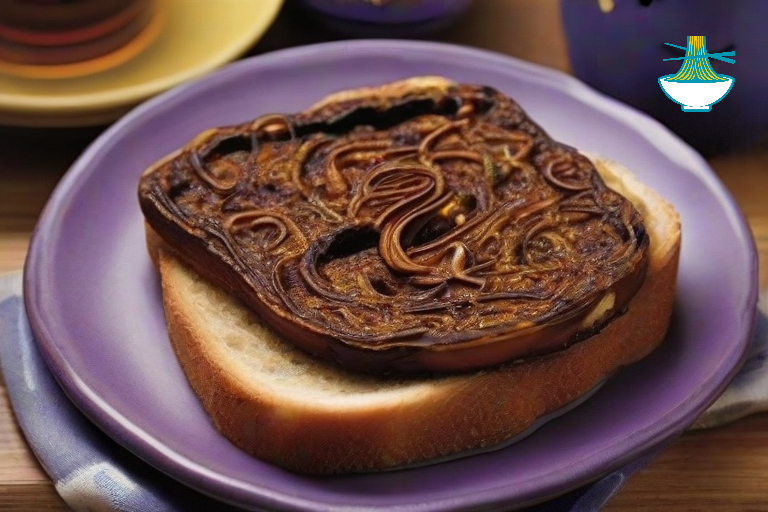Vegemite Toast is a beloved breakfast choice in Australia, known for its distinct savory, salty, and slightly bitter flavor. Made from yeast extract, a byproduct of beer brewing, Vegemite provides a unique alternative to traditional spreads like peanut butter or jam. Packed with essential B vitamins, particularly B1, B2, B3, and folate, it offers numerous health benefits, including promoting energy production, supporting a healthy nervous system, and boosting immunity. However, due to its high salt content, it should be consumed in moderation, especially for individuals monitoring their sodium intake. Vegemite Toast is not only a quick and easy meal option but also a nutrient-dense snack that contributes to a balanced diet when enjoyed responsibly.
Ingredients:
- 2 slices of bread
- 1-2 teaspoons of Vegemite
- Butter (optional)
Instructions:
- Toast the bread in a toaster or under the grill until it is golden brown.
- Spread butter (optional) on the toast while it is still hot.
- Using a knife, spread 1-2 teaspoons of Vegemite onto each slice of toast.
- Spread it thinly and evenly, making sure to cover the entire surface of the toast.
- Serve hot and enjoy your Vegemite Toast!
Note:
- It is important to spread the Vegemite thinly, as it is a strong and salty spread. You can adjust the amount of Vegemite to your liking, depending on how strong you want the flavor to be. Vegemite Toast can be served on its own or with a side of eggs, bacon, or other breakfast foods.
Frequently Asked Questions:
How can I make Vegemite Toast healthier?
- To make Vegemite Toast healthier, use whole-grain bread, add fresh vegetables like spinach or tomatoes, and include a source of protein, such as eggs or turkey slices, to make your meal more balanced and nutritious.
Is Vegemite Toast suitable for children?
- While Vegemite Toast can be a fun and nutritious meal for children, it is important to serve it in moderation due to the spread's high sodium content. Reduced-sodium versions can be a healthier option for younger kids.
Is Vegemite Toast appropriate for a low-sodium diet?
- Vegemite Toast is high in sodium, so it may not be ideal for individuals following a low-sodium diet. However, reduced-sodium Vegemite is available, and other alternatives like avocado or hummus can be used instead.
Can Vegemite Toast be a good snack after exercise?
- Vegemite Toast can serve as a light snack post-workout, as it provides carbohydrates for energy replenishment and B vitamins for muscle recovery. Pairing it with protein-rich foods like eggs or cheese can enhance its post-exercise benefits.
Can Vegemite be used in other recipes besides toast?
- Yes, Vegemite can be used in various recipes besides toast. It can be added to soups, stews, or marinades to enhance the umami flavor. You can also mix it with butter or cream cheese to make a savory dip or spread for crackers and vegetables.
What are the long-term effects of eating Vegemite Toast every day?
- While Vegemite Toast can be part of a balanced diet, consuming it daily may increase your sodium intake, which could negatively affect cardiovascular health over time, especially for those with high blood pressure or those at risk for heart disease.
What are the best alternatives to Vegemite for people on low-sodium or yeast-free diets?
- People on low-sodium diets can opt for reduced-sodium Vegemite or try spreads like avocado or hummus. Those avoiding yeast can choose alternatives such as tahini, peanut butter, or fruit-based spreads.

Nutrition Facts:
Vegemite is a good source of B vitamins, including thiamine, riboflavin, niacin, and folate. It is also low in fat and calories and is a good source of protein. Two teaspoons of Vegemite (8g) contains:
- Calories: 22
- Fat: 0.1g
- Carbohydrates: 1.1g
- Protein: 2.5g
- Sodium: 391mg
2 slices of bread (assuming standard white bread):
- Calories: 160-180 kcal
- Protein: 4-6g
- Carbohydrates: 30-40g
- Dietary Fiber: 2-4g
- Sugars: 4-6g
- Fat: 2-4g
- Saturated Fat: 0.5-1g
- Sodium: 300-400mg
benefits:
- Source of Carbohydrates: Bread provides a quick source of energy due to its carbohydrate content, which is important for daily activities and brain function.
- Dietary Fiber: Whole grain breads especially are a good source of dietary fiber, which aids in digestion and helps maintain a healthy digestive system.
- B Vitamins: Bread, particularly those made from whole grains, contains B vitamins like niacin and thiamine, which are essential for metabolism and overall health.
1-2 teaspoons of Vegemite:
- Calories: 10-20 kcal
- Protein: 1-2g
- Carbohydrates: 1-2g
- Dietary Fiber: 0g
- Sugars: 0g
- Fat: 0g
- Saturated Fat: 0g
- Sodium: 200-400mg
benefits:
- Rich in Vitamin B: Vegemite is a concentrated source of B vitamins, particularly vitamin B12, which is important for nerve function and the production of DNA.
- Source of Folate: Folate, also found in Vegemite, is important for cell division and helps prevent certain birth defects.
- Low in Fat and Calories: Vegemite is a low-fat, low-calorie spread, making it a healthier choice compared to other spreads high in saturated fats.
Butter (optional):
- Calories: 36 kcal per teaspoon (assuming unsalted butter)
- Protein: 0.04g
- Carbohydrates: 0g
- Dietary Fiber: 0g
- Sugars: 0g
- Fat: 4g
- Saturated Fat: 2.5g
- Sodium: 0.02g
benefits:
- Source of Healthy Fats: Butter contains healthy fats that are essential for hormone production and cell membrane structure.
- Vitamins A and D: Butter is a good source of vitamins A and D, which are important for vision, immune function, and bone health.
- Enhances Flavor and Texture: Butter can enhance the flavor and texture of food, making it more enjoyable to eat.
Overall, Vegemite Toast is a delicious and healthy breakfast option that is popular in Australia and enjoyed by many around the world.


Comments